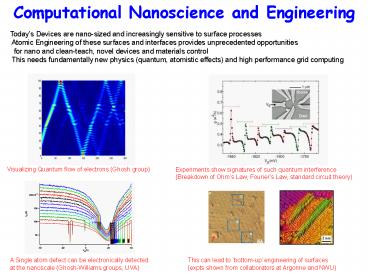Computational Nanoscience and Engineering PowerPoint PPT Presentation
Title: Computational Nanoscience and Engineering
1
Computational Nanoscience and Engineering
- Todays Devices are nano-sized and increasingly
sensitive to surface processes - Atomic Engineering of these surfaces and
interfaces provides unprecedented opportunities - for nano and clean-teach, novel devices and
materials control - This needs fundamentally new physics (quantum,
atomistic effects) and high performance grid
computing
Visualizing Quantum flow of electrons (Ghosh
group)
Experiments show signatures of such quantum
interference (Breakdown of Ohms Law, Fouriers
Law, standard circuit theory)
A Single atom defect can be electronically
detected at the nanoscale (Ghosh-Williams
groups, UVA)
This can lead to bottom-up engineering of
surfaces (expts shown from collaborators at
Argonne and NWU)
2
Unified approach to nano-electronics
- Versatile Wide variety of materials (molecules,
nanotubes, spintronics, Q. dots..) - Flexible (atomistic to continuum, classical to
quantum) - Modular (can independently refine description of
contacts, device etc)
3
Success Stories
MRS Bulletin 04
First principles conjugated molecular
Ivs (parameter free matching of expts)
Molecular Quantum Dots correlating measured
spectra with atomic bonding
Experiment, PRL 02
Theory, PRB 08
Extracting many-body spectral signatures
4
Future Directions
Atomic Engineering of Thermal Interfaces (NSF
CAREER)
Nano barcode sensor for single atom
defects (NSF-NIRT/CAREER)
All graphene circuits (UVA-FEST)
Bio-inspired non-equilibrium switching (NRI-INDEX
)
Spin torque for low power non-volatile
memory (DARPA)
PowerShow.com is a leading presentation sharing website. It has millions of presentations already uploaded and available with 1,000s more being uploaded by its users every day. Whatever your area of interest, here you’ll be able to find and view presentations you’ll love and possibly download. And, best of all, it is completely free and easy to use.
You might even have a presentation you’d like to share with others. If so, just upload it to PowerShow.com. We’ll convert it to an HTML5 slideshow that includes all the media types you’ve already added: audio, video, music, pictures, animations and transition effects. Then you can share it with your target audience as well as PowerShow.com’s millions of monthly visitors. And, again, it’s all free.
About the Developers
PowerShow.com is brought to you by CrystalGraphics, the award-winning developer and market-leading publisher of rich-media enhancement products for presentations. Our product offerings include millions of PowerPoint templates, diagrams, animated 3D characters and more.

